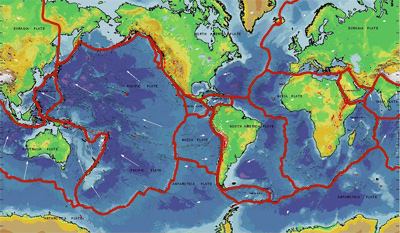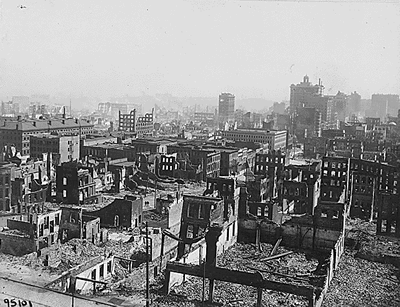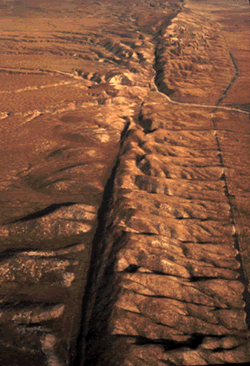The San Andreas fault in California is very distinct in the Carrizo Plain east of the city of San Luis Obispo, CA. Many faults can not be seen at the Earth's surface like this.
Click on image for full size
USGS
Why Do Earthquakes Happen?
When giant blocks of rock are moved by plate tectonics, they are bound to bump into each other. Sometimes they slide smoothly past each other along faults. Other times the blocks of rock get stuck together and can't move smoothly. That might lead to an earthquake.
There might be no movement along a fault for a long time if the blocks of rock are hitched together. However, plate tectonic force continues to push the rocks and the energy builds up over many years.
Eventually the energy is released as an earthquake. The rock breaks and moves into a new position. Vibrations called seismic waves travel outward in all directions from the point where the energy was released. These seismic waves are what people on the surface of the Earth feel when they are in an earthquake.
There are different types of seismic waves. Some rumble the ground surface. Other types of seismic waves travel through the planet.
You might also be interested in:

Many forces change the surface of the Earth over time. The largest force that changes our planet's surface is movement of Earth's outer layer in a process called plate tectonics. As shown in this picture,
...more
The ground underfoot might seem like it's not going anywhere but it is. It moves. If it moves all of a sudden the ground shakes. That's an earthquake! Earthquakes happen as pieces of the Earth's crust
...more
During an earthquake, the ground shakes making it difficult or impossible to stand up without falling. The land can also roll in waves - sinking in some places and rising in others. How does all this moving
...more
Most people in San Francisco, CA were still asleep when an earthquake shook them awake early in the morning of April 18, 1906. It was a very strong earthquake. It lasted for only about a minute, but caused
...more
Plates at our planet’s surface move because heat in the Earth’s core causes molten rock in the mantle layer to flow. We used to think the Earth’s plates just surfed on top of the moving mantle, but now
...more
Spotting minerals is fun! There are many different types of minerals. Each has a different name and special traits. You can learn more about minerals by looking closely at them to understand their special
...more
This mineral is called quartz! Sometimes it looks white like milk but usually it looks clear like glass, sometimes with a little pink or gray tinge of color. You can find crystals of quartz in many different
...more















